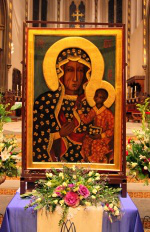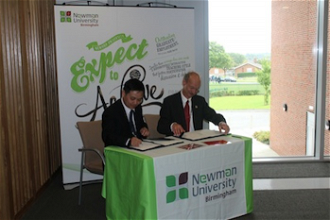Birmingham: pilgrims venerate Icon of Our Lady of Chestochowa

Icon of Our Lady of Czestochowa, in St Chad’s Cathedral, Birmingham. Image: Peter Jennings
Large crowds of people venerated the Icon of Our Lady of Czestochowa, the Black Madonna of Poland during its short but memorable visit to the Metropolitan Cathedral and Basilica of St Chad, in Birmingham. The Cathedral was full on Friday afternoon, 9 November, when the replica Icon of Our Lady of Czestochowa arrived at St Chad’s Cathedral from Walsingham as part of an international tour of 24 counties from Vladivostok in Russia to the Marian Shrine in Fatima at Portugal, where it will arrive on 8 December, the Feast of the Immaculate Conception.
A special Welcome Liturgy, including the Rosary, was led by Canon Gerry Breen, Cathedral Dean, who welcomed the congregation on behalf of the Most Reverend Bernard Longley, Archbishop of Birmingham, who had an engagement away from the diocese.
During his homily Canon Breen said: “It is our joy to welcome to Saint Chad’s Cathedral this powerful image of Our Lady of Czestochowa, the Black Madonna. The remarkable pilgrimage of this Icon began in Russia and Kazakhstan and will end at the Marian Shrine of Fatima. As the geographical journey reaches its end, we pray that the spiritual pilgrimage will continue in the hearts and lives of those graced by this Icon.”
Canon Breen said: “How timely it is too, that this Ocean to Ocean Pilgrimage of the Icon of Our lady of Czestochowa takes place at the beginning of the Year of Faith inaugurated by His Holiness, Pope Benedict XVI during a Month of Mary, the month of October.”
The Cathedral Dean spoke briefly about the recently concluded International Synod of Bishops in Rome, attended by Archbishop Bernard Longley as one of the Synod Fathers, along with his colleagues on the Pontifical Council for Promoting the New Evangelisation.
He said: “The Synod of Bishops referred to Mary as the ‘Star of the New Evangelisation’. This title used often by Blessed John Paul II and Pope Benedict, speaks of Mary as the First Evangelist and Disciple of the Lord. The task of any disciple or evangelist is not to speak of ‘self’ but of Jesus Christ; and to lead others to encounter him within the experience of their daily lives.”
Canon Breen added: “There is another beautiful title of Mary which is associated with this Icon of Czestochowa, and that title is from the Greek ‘Hodegetria’ – which in English translates as ‘One who shows the way.’
“In this Icon we see the Blessed Virgin directing attention away from herself by gesturing with her right hand towards Jesus as the source of Salvation – the logos, the Living Word of God.
“In turn, the Christ Child extends his right hand towards us who gaze upon him– as if to impart a blessing, while holding in his left hand the written word of God, the Holy Gospel. Mary, as Hodegetria, is never the Way, but she gently points to him who is the Way, the Truth and the Life, Jesus her Divine Son.
Canon Gerry Breen concluded: “Mary, the Star of the New Evangelisation, invites us once more to turn our hearts and lives to her Son as we pray the Psalter of Mary, the Holy Rosary. We offer the Sorrowful Mysteries for the Child in the Womb and the work of the Pro-Life movements which is the focus of the Icon’s Pilgrimage.”
St Chad’s Cathedral was full again at 7.30pm for sung Vespers (Evening Prayer) led by priests from the Russian and Romanian Orthodox Churches and attended by communities from across the Archdiocese of Birmingham and beyond.
The superb chanting and singing of the Father Archpriest Michael Gogoleff of the Russian Orthodox Church resounded throughout the great Pugin masterpiece situated on the edge of the famous Jewellery Quarter near the centre of Birmingham.
At the end of Vespers members of the congregation individually venerated the Icon of Our Lady and also a silver cross that contained the relics of St Chad, a Patron of the Archdiocese of Birmingham. St Chad Bishop of Lichfield in Mercia, who died on 2 March 672, is also numbered among the Orthodox Western Saints.
The following day St Chad’s Cathedral was packed to overflowing, with people standing on the pavement outside the main West Door, for the special Polish Mass with representatives from the Polish Community across the Midlands. Afterwards the Icon of Our Lady of Czestochowa continued on its journey to Manchester and Scotland and then Ireland.
On a personal note, the visit of the Black Madonna of Poland to St Chad’s Cathedral kindled memories I have of covering the second Pastoral Visit by Blessed Pope John Paul II back to his Polish homeland in June 1983. He began his eight day pilgrimage at Okecie military airport near Warsaw, the capital, on 16 June. At the time Poland was under martial law which had been imposed by the communist regime in December 1981.
I was privileged to be present on Sunday morning, 19 June 1983, when Pope John Paul II presided at Mass in honour of Our Lady of Czestochowa attended by an estimated two million pilgrims gathered in fields near the walls of the Jasna Góra monastery. It was an unforgettable occasion.
The media was situated near the temporary altar in the grounds of the monastery with a spectacular view of the vast crowds below. Light rain fell steadily during a powerful sermon given by Pope John Paul II, a hero to the Polish people.
Cardinal Karol Wojtyla, Archbishop of Krakow, as he was then, was elected Pope on 16 October 1978 - the first non-Italian Pope since the sixteenth century and the first from a communist country.
Speaking in Polish Pope John Paul II said: “The evangelization of freedom at Jasna Góra has another dimension. It is the dimension of the freedom of the nation, the free homeland, restored to the dignity of a sovereign State. The nation is truly free when it can shape itself as a community determined by unity of culture, language and history. The State is firmly sovereign when it governs society and also serves the common good of society and allows the nation to realize its own subjectivity, its own identity.”
Blessed Pope John Paul II as he later became, concluded: “During my previous pilgrimage to my homeland in 1979 I said at Jasna Góra that here we have always been free. It is difficult to express in a different way what the Image of the Queen of Poland became for all Poles during the time when their homeland was wiped off the map of Europe as an independent State.
“Yes! Here at Jasna Góra there also rested the hope of the nation and the persevering effort towards the recovery of independence. ‘Before your altars we bring entreaties, O Lord, deign to restore to us a free homeland.’
“And it is here too that we have learned fundamental truth about the freedom of the nation: the nation perishes if it deforms its spirit - the nation grows when its spirit is ever more purified, and no external power is able to destroy it!”
Communism collapsed in Poland seven years later during 1990. General Jaruzelski resigned as the President of the Republic of Poland and was succeeded by Lech Walesa, leader of the independent trade union “Solidarity” (Solidarność in Polish), after the December 1990 election.
*For further information about “Ocean to Ocean – with the Icon of Jasna Góra in defence of life” see website: www.fromoceantoocean.org.uk


















